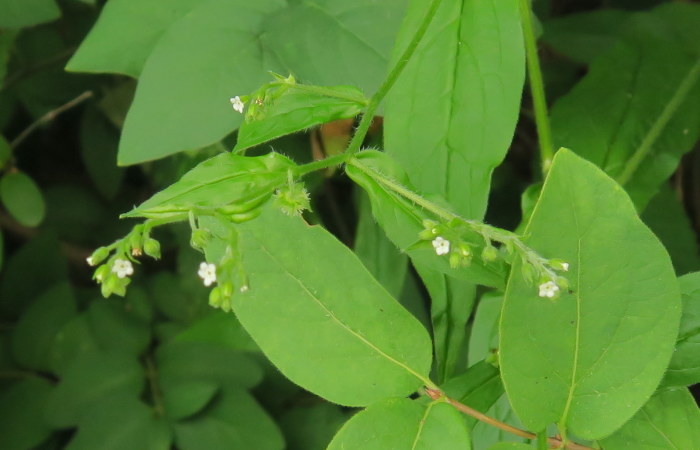Today’s featured plant won’t win any popularity contests. In fact, I know people who rip Virginia stickseed (Hackelia virginiana) out of the ground as soon as they identify it anywhere on their property.
This common woodland species, sometimes just called stickseed, has unimpressive flowers that become irritating burs. The burs spawned the common names beggar’s lice or sticktight. I don’t pull up these plants like I do with garlic mustard, but I keep an eye out for them so my shoes, clothes, and dog don’t end up covered in burs.
Virginia stickseed is native to most of the U.S. and Canada east of the Rocky Mountains. I frequently see it in the woods or near woodland edges. According to the Illinois Wildflowers site, “Stickseed prefers disturbed wooded areas and it is rather weedy.”
I took the pictures enclosed below in Windsor Heights, Clive, or Urbandale.
Passing by this plant, you might overlook the tiny white flowers, which are only about one-eighth inch in diameter.
A couple of closer looks at the flowers:
Some catnip is blooming on the left.
I took the next three pictures at a butterfly garden along the Urbandale bike trail. I would guess the Virginia stickseed was a “volunteer” from the nearby woods rather than part of the seed mix. The large yellow flower is a black-eyed Susan. Some daisy fleabane flowers are in the background, near the left.
The pink flowers here are known as wild bergamot, bee balm, or horsemint.
In this wider view, the larger flowers overshadow the Virginia stickseed in bloom.
The Minnesota Wildflowers describes the fruit of Virginia stickseed this way: “Fruits are round, wider than the flower but less than ¼ inch in diameter, divided into four nutlets with dense velcro-like prickles covering the outer surfaces.” You can see these developing in this picture, which I took last summer.
I went out this morning to photograph Virginia stickseed plants with burs developing. Some are less than two feet tall but others are double that height.
Near American bellflower plants:
They’re a little hard to see, but several Virginia stickseed plants are in the background, behind the sweet Joe-Pye weed:
Battle of the woodland plants with tiny white flowers! The blossoms on white vervain (on the right) can be less than one-eighth inch across.
The flower heads of white snakeroot (on the right) each contain a cluster of disk flowers that are about one-sixth of an inch in diameter.
The purple flower in the lower right corner is the non-native (but widespread) chicory.
When I mentioned in a Facebook group last year that I was planning a post about plants with sticky burs, the wildflower fans expressed a resounding dislike for Virginia stickseed:
At that time, occasional Bleeding Heartland contributor Lora Conrad shared this picture of her collie Logan after a run-in with Virginia stickseed.
Wendie Schneider photographed her dog before picking the burs off the ear fur.



















1 Comment
I let most native plants on my land keep growing...
…but I cut down Virginia stickseed close to the house. I can still marvel at the amazing ability of the tiny seeds to attach so efficiently without having to wrassle with ’em on my clothes.
This post also reminds me that years ago, someone at the Neal Smith Refuge did some research on prairie seed conveyance via bison by pulling a rough bison model covered with an actual bison hide through the prairie. I think more woodland plants may have sticky seeds because woodland winds don’t do seed dispersal as well as stronger winds on open grasslands. But prairies do have some sticky seeds, and I’ll bet that bison hide picked up a whole lot of tick trefoil.
PrairieFan Fri 7 Aug 3:00 AM